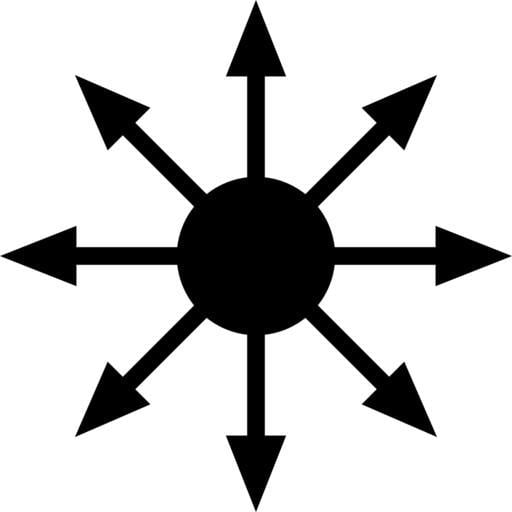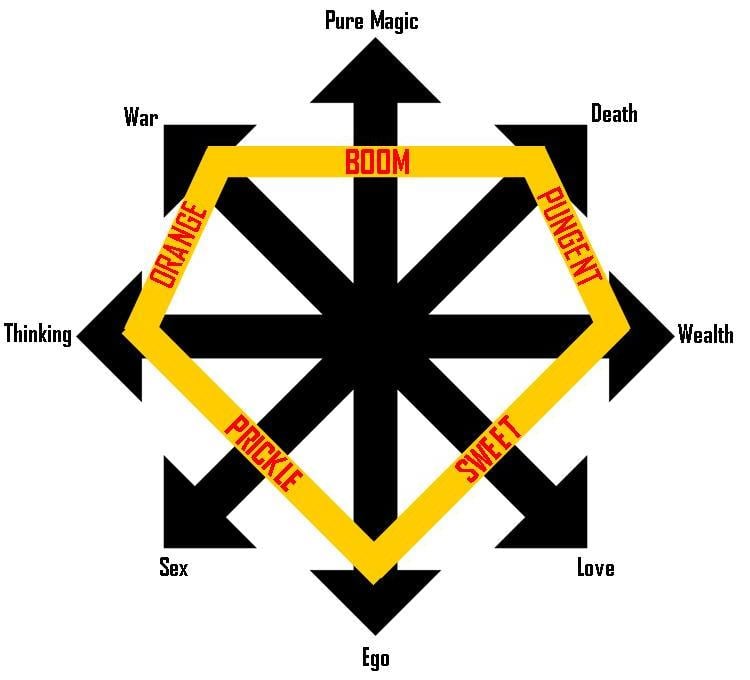Hey, you know what? We haven’t talked about Chaos Magic in, like, forever. Let’s get back on that.

A few days ago, Mat Auryn tweeted the following, which got me ruminating on what does and does not fall under the banner of Chaos Magic:
People now seem to misuse the term Chaos Magic as much as they do Shadow Work.
He is absolutely correct (and I’ll be sharing some thoughts on Shadow Work in the near future as well). And I am happy that there’s a renaissance of interest in Chaos Magic, but as it grows in renewed popularity, we’re seeing more misconceptions along the lines of, “Chaos Magic is whatever you want it to be,” when… yeah, it’s really not.
There is a framework to Chaos Magic that makes it what it is, and we need to understand that framework if we’re going to practice it effectively. And a great place to start as we’re learning is with its most recognizable symbol.
The Chaos Star
The design that came to be known as the Chaos Star was originally devised in the early 1960s by the writer Michael Moorcock for his Elric of Melniboné stories.

The symbol trickled from fiction to appear iconically in the Warhammer role-playing game, and it eventually wriggled its way into occultism, where it finally solidified as a symbol of Chaos Magic. It is also known as the Chaostar and the Sigil of Chaos, and if it’s mapped out three-dimensionally, it’s called a Chaosphere.

The Star does not really have a concrete meaning, although we can certainly squeeze a variety of interpretations out of it. The arrows can represent the eight points of the compass, or the symbol as a whole can represent the Big Bang, with matter and energy launching ballistically in all directions. Or we can look at it as a representation of Chaos itself, being the potential and momentum behind all action with no specific destination in mind, other than where we decide to take it.
How we use the colors of the Chaos Star is entirely up to us, and we can even combine them. For instance, if I was doing a ritual to protect investments, I might use red and blue candles, cords, dyed oils, etc. in my work, while invoking spirits of War and Wealth. Or, since red + blue = purple, I could use Purple Magic to create opportunities for my investments to grow without interference.
The point here is that once we’ve got the structure of the colors down, we can do a lot of really cool stuff within it. Chaotic stuff, even.
Zeals on Wheels
The arrows themselves are not static, and in Chaos Craft: The Wheel of the Year in Eight Colours, Julian Vayne and Steve Dee rearrange the colors (while keeping the polarities intact) to align them with the Wiccan Sabbats, like so:

- Octarine – Winter Solstice
- Green – Imbolc
- Orange – Spring Equinox
- Purple – Beltane
- Yellow – Summer Solstice
- Red – Lammas
- Blue – Autumn Equinox
- Black – Samhain
Within this paradigm, the magic being practiced corresponds to the cyclical celebrations. Since Lammas is a time of sacrifice, we could take the opportunity for a Red ritual to venerate Mars (who is the plow as well as the sword); or, during Samhain, our magic would be Black, in that we’re honoring and communing with the dead. In these cases, the magic is bolstered by the season, making our work even more effectual.
The Discordian Diamond
So this is my own little contribution to Chaos Magical Theory. Remember the Discordian Elements? If not, they’re Pungent, Sweet, Prickle, Orange, and Boom. And here’s how I apply them to the Chaos Star:

As I see it, the Discordian Elements are not set points, but spectrums around the Star. Pungent, for example, connects Death and Wealth (the odor of decay; the smell of old money), whereas Prickle runs the gamut from Ego (a lightbulb going off over one’s head) to Sex (goosebumps when a lover whispers something naughty in one’s ear) to Thinking (the electric jolt of a risk paying off).
What I have found is that the forms of magic are at their most potent within their given spectrums. To cast money spells, I’ve drawn sigils on bay leaves, charged them, then buried them by my front door: As the leaves break down in the soil, so my money grows. But the main components of the spell (the aroma of the bay and its decomposition) are aspects of Pungent, and as such, they resonate well together and get me the results I’m looking for.
A Random Anecdote
Many years ago, I worked in Online Customer Support, and part of my job was training new employees on our system.
On the first day of one particular training class, a new guy raised his hand and asked, “If we find a better way to do things, what’s the procedure for implementation?” And I was like, “Well, you’d come to me, and we’d discuss it. But considering you don’t know how we do things yet, I’d suggest you wait a bit and see what you can learn before trying to improve anything.”

There’s an intentional order to the information in this post (which is similar to how I taught my OCS classes): I started with the history of the Chaos Star, then covered what Carroll and Channing did with it, then touched on Vayne’s and See’s brainchild before presenting my own. Because that’s how ingenuity works, both within the occult and without. Instead of randomly pulling ideas out of the ether and stamping them Chaos Magic, we need to see what’s come before, understand how it works, try it out ourselves, and then start firing up our own experiments and hot takes.
Like I said at the start of all this, Chaos Magic is not “whatever we want it to be.” But once we have our foundations in place, we can grow and explore and get whatever results we want. And then surprise the hell out of ourselves with the innovations we uncover.


















